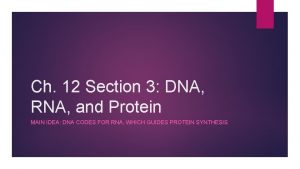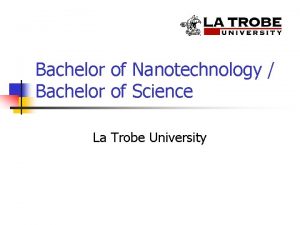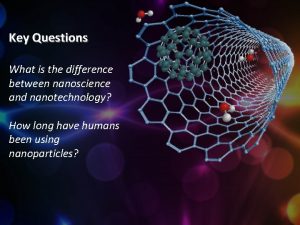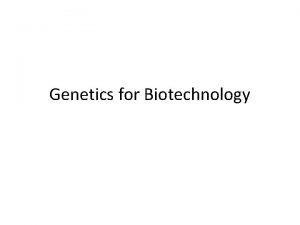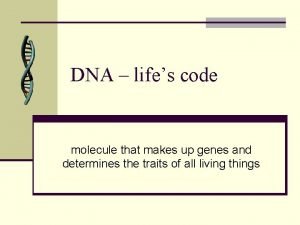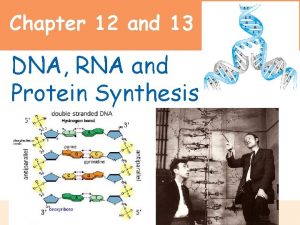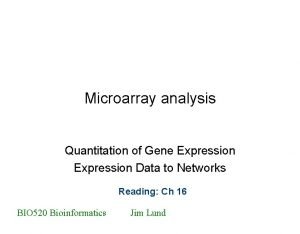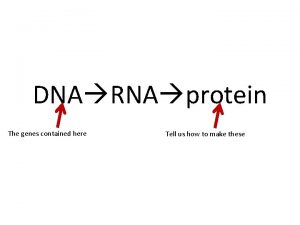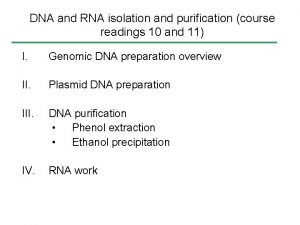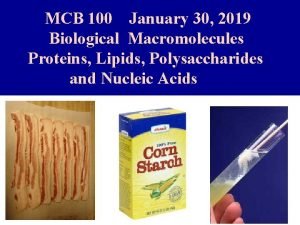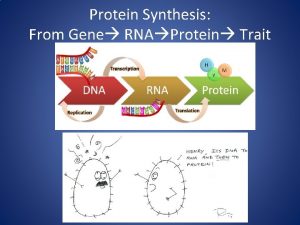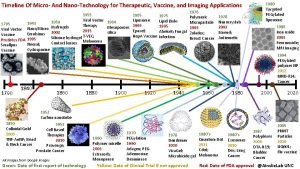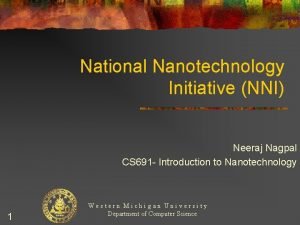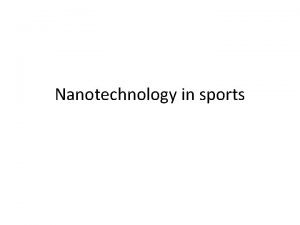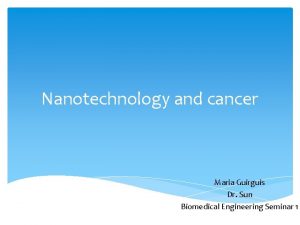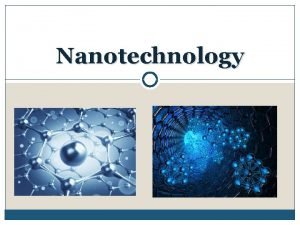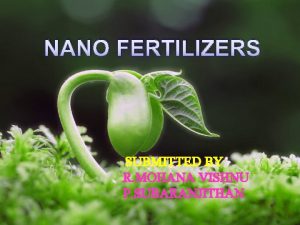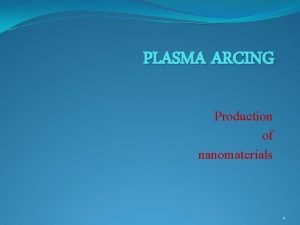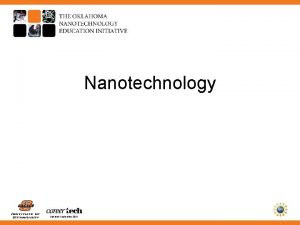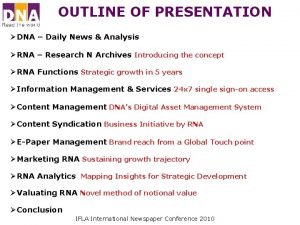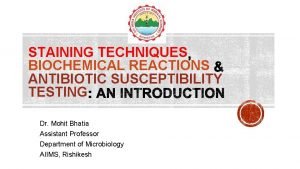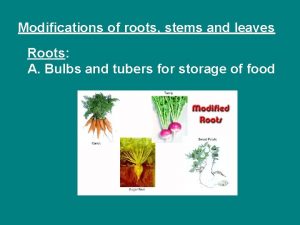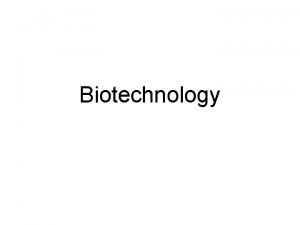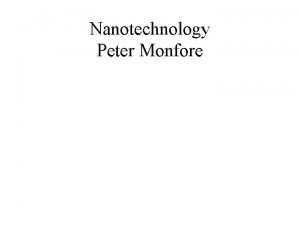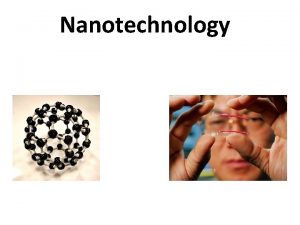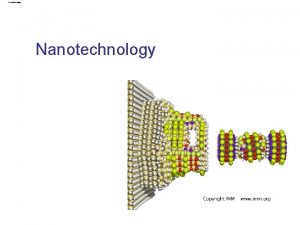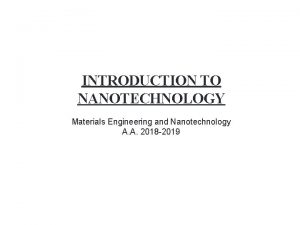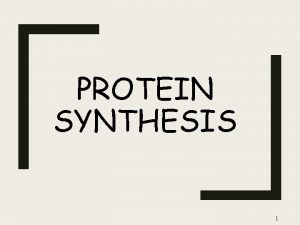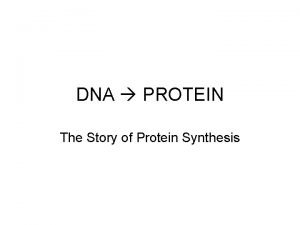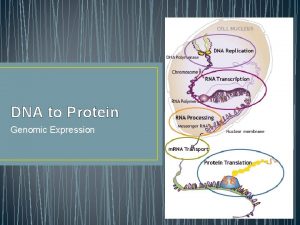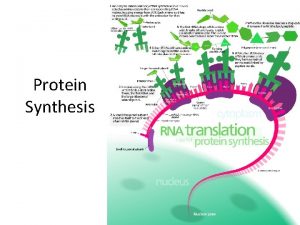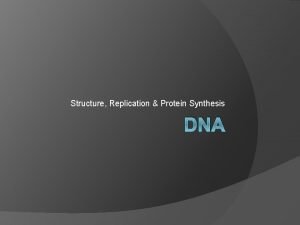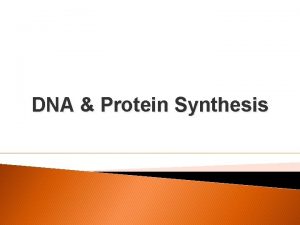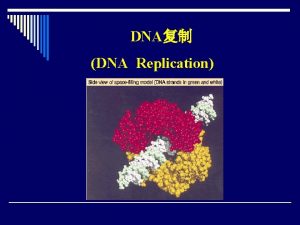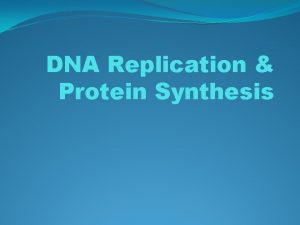Materials Modification in Nanotechnology DNA and Protein Analysis
















































- Slides: 48

Materials Modification in Nanotechnology DNA and Protein Analysis using Nanotechnology Terence Kuzma

Outline • Micro array Technology • Microfluidics Overview • Basic Design and Material Processes

Micro. Bio. Lab • This is a device that can dissect a very small amount DNA, protein, cells, or drug • It can chemically analyze a liquid sample 10, 000 times smaller than commercial analytical instruments • This time-saving chip could be built for genetic diagnosis, DNA fingerprinting, and drug research • Conserves test media, and reduces disposal issues 3

Micro Arrays • How they work – Microarrays work by exploiting the ability of m. RNA to bind to DNA templates. • What they do – Analyzes gene expressions consisting of small membranes. – Can determine the expression levels of hundreds or even thousands of genes in cells by measuring the amount of m. RNA in a single experiment http: //genechip. com/index. affx 4

Micro Arrays Uses • Test structure that can be used with microfluidic technology to interrogate samples. • Used to understand fundamental aspects of growth and development. • Also used to identify and classify DNA sequence information and assign their function. 5

Micro Arrays • Why they are important – You can survey large number of genes rather quickly. – Can compose and contrast cells and tissues from being healthy of diseased. – Show and why certain genes can or can not work together. 6

Micro Arrays http: //members. cox. net/amgough/Fanconigenetics-PGD. htm 7

Advantages/Disadvantages • Advantages – Very Small – Disposable – Sealed – Portable – Very Fast response time • Disadvantages – Takes place of jobs 8

Outline • Micro array Technology • Microfluidics Overview • Basic Design and Material Processes

Microfluidics Overview Microfluidics is the science of designing, manufacturing, and formulating devices and processes that process and handle volumes of fluid on the order of Nano (10 -9) or Pico (10 -12) liters. Liquids in nanoliters 30 n. L = 1/1000 th of 1 droplet 10

Growth of Microarrays Contributed by Frédéric Breussin, Business Unit Manager Microfluidics & Medical Technologies, Yole Développement

Growth of number of ISI publications found with microfluidic and nanofluidic over the past 20 years Chemical Society Reviews 12 From microfluidic applications to nanofluidic phenomena Albert van den Berg , Harold G. Craighead and Peidong Yang

Microfluidics Overview • Microfluidic devices handle small amounts of fluid. Good when only small amounts are available, or good for conservation • Generally use small amounts of energy • Sealed system so contamination is well controlled • Small size leads to mobility, no lab needed • Reaction can be fast 13

Microfluidics Overview Microfluidics is a multidisciplinary field intersecting engineering, physics, chemistry, biochemistry, nanotechnology, and biotechnology, with practical applications to the design of systems in which small volumes of fluids will be handled small volumes (µL, n. L, p. L, f. L) small size low energy consumption effects of the micro domain Typically fluids are moved, mixed, separated or otherwise processed. Numerous applications employ passive fluid control techniques like capillary forces http: //en. wikipedia. org/wiki/Microfluidics

Physics of Microfluidics • The small scale of microfluidics leads to unique conditions and considerations • Factors like surface tension, unique flow characteristics, air traps, and many other factors contribute to the complexity of microfluidics. • We will briefly examine selected factors – Flow – Mixing 15

Physics of Flow Electrokinetic effects, general term to describe the movement of ions in a fluid that is subjected to an electric potential. • Two major types of flow types, electroosmosis, or electrophoesis • Electroosmosis, sidewall driven • Electrophroesis, particle flow 16

Electroosmosis • If the walls of a channel have an electric charge (-) ions in the fluid with an opposite charge (+) will be attracted to the walls. • A layer of immobile ions forms at the channel surface while a layer of mobile ions forms at the fluid side (electric double layer). • When an electrical potential is applied to the channel the ions in the fluid will be attracted to the opposite pole • These ions will drag along the remaining fluid. 17

Electro-Osmotic Flow (EOF) • Relates greatly to electrokinetic effects • Surface of fluid develops a charge, which influences fluid flow • Creates different layers in the fluid which contain different charges, such as the stern and diffuse layers 18

Electro-Osmotic Flow

Advantages Disadvantages • No moving parts. • No wear. • Low diffusion of the laminar flow. • Simple design. • High voltages (100’s – 1000’s. V) makes it difficult to miniaturize. • Chemical absorption to the channel walls. • Sensitive to fluid and channel chemistry. • Joule heating. 20

Electrophoresis • Movement of charged particles or molecules that are subjected to an electric field • “Cations move toward the cathode and anions move toward the anode. ”

22

Mechanical Micropumps • Fluidics using these pumps are delivered in a series of small volumes. • This creates a pulsating flow, as would a heart pumping blood. • Reciprocating pumps can have valves to stop backflow of fluids. • The advantage of not having valves is the simple construction. 23

Micropumps • Piezoelectric Pump openi. nlm. nih. gov 24

Some Non-ideal Considerations • Generally fluids at the micro scale do not want to mix • Pressure wave affects mixing • Curves in the design may cause mixing • Materials may have intrinsic properties that cause mixing or non-mixing • Because there are many variables, computer simulations are often used in the design of microfluidics 25

Laminar Flow • When all of the fluid particles move in paths parallel to the overall flow direction. • At the extremely small scale, fluids exhibit characteristics of laminar flow. – When multiple fluids are introduced, they want to flow in straight lines with little to no mixing occurring. http: //wetpong. net/wetpong

Laminar Flow http: //www. nist. gov/pml/div 683/command_042710. cfm 27

Laminar Flow • Laminar flow is the norm, and it is often not desired in a device • No turbulence • Fluids mix by diffusion only • Can be useful for fluid control, but makes solution formation difficult Multi-level laminating mixer Gray et al. , Sens. Actuators, A 77, 1999 28

Fluid Mixing • Dealing with liquids in the amounts of nanoliters – 30 n. L = 1/1000 th of 1 droplet • Reactions occur in milliseconds • Macro mixing methods are difficult to miniaturize to this scale, smaller channels have laminar flow • Generally bends, turns, and increasing channel dimensions increase mixing 29

Reynolds Number • “Quick check number” used to determine if a fluid will have laminar or turbulent characteristics • Represents a ratio of momentum forces to viscous forces in fluid (liquid or gas) flow • Expresses the relationship of fluid density, velocity, channel dimensions, and viscosity coefficient. There are other variables that are not considered by this quick check equation. • Named after Osborne Reynolds (1824 -1912) 30

Reynolds Number Quick approximation to determine whether the flow of a typical fluid is laminar or turbulent. • • D = Pipe Diameter V = Fluid Velocity p = Fluid Density µ = Fluid Viscosity 31

Reynolds Number • Liquids flow smoothly when they have a low Reynolds Number • Microchannels with only 10’s of microns in dimensions create small Reynolds Numbers creating linear, turbulent-free streams • Mixing could be desirable to have a reaction, and low Reynolds numbers prevent mixing 32

Reynolds Number • For Laminar Flow Re << 1 • For Turbulent Flow Re >> 1 • At the extremely small scale (70 micron diameter channels) fluids will flow in a laminar fashion. • This is a problem For example, for a DNA lab on a chip to work, materials must be mixed. Small channel will prevent this from happening

Laminar flow depends upon boundary geometry • • Cylindrical pipe Re < 2100 Parallel walls Re ≈ 1000 Wide open channel Re ≈ 500 Around a sphere Re ≈ 1 34

Water in a 50 ųm channel • • D = 50 ųm V = 1 m/s p = 997. 0 kg/m 3 µ =. 89 Pa · s Re =. 056 < 2100 = Laminar flow 35

Peclet Number • Determines whether Pe = vl/D diffusion or convection is the dominant • ν = velocity of the fluid means of mass • l = characteristic transportation. length of the fluid • D = diffusion • Diffusion > 1 coefficient • Convection < 1

Peclet Number • When fluids flow laminarly, the primary means of mass transportation is diffusion (extremely slow process). • To allow for mixing to occur quickly, must change flow so that it is turbulent, (meaning convection is the primary means of mass transportation). • In the next section, mixing will be accomplished with 90 -degree bends to create fluid convection.

Mixers/Stirrers • Microfluidic devices usually have laminar flow. The fluids entering must be mixed in the chip to get the desired end product. • The most popular types of mixing is using channel angles. • Mixing can also be done by using stirrers (electronic or magnetic). Could be costly. 38

Mixers • Serpentine mixers 39 http: //www. niherst. gov. tt/scipop/sci-bits/microfluidics. htm

FLUID MIXING IN PLANAR SPIRAL MICROCHANNELS Illustration of Dean flow effects in a curved microchannel (‘i’ and ‘o’ denote the inner and outer channel walls respectively). The transverse flow field is characterized by the presence of two counter-rotating vortices located above and below the channel midplane. At higher k, the combined action of these vortices cause two fluid streams to almost completely switch positions within the channel. Sundersan Argon P. , and Victor M. Ugaz. "Fluid mixing in planar spiral microchannels. " Lab on a Chip 6. 1: 74 -82

Dean Number • The Dean number is typically denoted by the symbol D, and is defined as http: //en. wikipedia. org/wiki/Dean_number

Multivortex micromixing Sundarsan, Arjun P. , and Victor M. Ugaz. "Multivortex micromixing. " Proceedings of the National Academy of Sciences 103. 19 : 7228 -7233

Mixing intensity as a function of Re at the end of each section for the four-arc (A), six-arc (B), eight-arc (C) and ten-arc (D) spiral channels. Sundersan Argon P. , and Victor M. Ugaz. "Fluid mixing in planar spiral microchannels. " Lab on a Chip 6. 1: 74 -82

Multivortex Micromixing Sundarsan, Arjun P. , and Victor M. Ugaz. "Multivortex micromixing. " Proceedings of the National Academy of Sciences 103. 19 : 7228 -7233

Valves • The majority of vales in microfluidics are like diodes, with flow limited to one direction. • This reduces backflow, block-ups, and contamination. • Common terms for this type of device are gates, check, or flapper valves. 45

Valves • Cantilever (microvalve) Application: switches, resonators, chemical and biological sensors, accelerometers ip. sandia. gov 46 http: //www. uspto. gov/web/patents/classification/cpc/html/def. B 81 B. html

Integrating the Parts • Pump are used to move the fluid through the channels. • Valves are used to control where and which direction the fluid flows. • Mixers/stirrer keep fluids together and stop laminar flow. • Many devices are made from the simple components reviewed 47

Outline • Micro array Technology • Microfluidics Overview • Common Materials and Processes
 Chapter 11 dna and genes
Chapter 11 dna and genes Chapter 12 section 3 dna rna and protein
Chapter 12 section 3 dna rna and protein Rna and protein synthesis study guide
Rna and protein synthesis study guide Carrier vs channel proteins
Carrier vs channel proteins Protein-protein docking
Protein-protein docking Disadvantage of nanotechnology
Disadvantage of nanotechnology Difference between nanoscience and nanotechnology
Difference between nanoscience and nanotechnology Sciwo
Sciwo Coding dna and non coding dna
Coding dna and non coding dna Dna rna protein central dogma
Dna rna protein central dogma Dna rna protein central dogma
Dna rna protein central dogma What is the goal of replication
What is the goal of replication Dna to protein steps
Dna to protein steps Microarray analysis
Microarray analysis Dna rna protein
Dna rna protein Dna rna protein diagram
Dna rna protein diagram Dna-protein interactions
Dna-protein interactions Dna rna protein trait
Dna rna protein trait Timeline of nanotechnology
Timeline of nanotechnology What is nanotechnology
What is nanotechnology Nanotechnology for kids
Nanotechnology for kids Nanotechnology introduction
Nanotechnology introduction Nanotechnology fact or myth articles
Nanotechnology fact or myth articles Disadvantages of nanotechnology
Disadvantages of nanotechnology Nanotechnology
Nanotechnology What is the nanotechnology
What is the nanotechnology Conclusion of nanotechnology
Conclusion of nanotechnology Interpretations of moore's law assert that:
Interpretations of moore's law assert that: Plasma arcing
Plasma arcing Nanotechnology definition
Nanotechnology definition What is nanotechnology
What is nanotechnology Nanotechnology
Nanotechnology Function of dna polymerase 3
Function of dna polymerase 3 Bioflix activity dna replication nucleotide pairing
Bioflix activity dna replication nucleotide pairing Enzyme involved in dna replication
Enzyme involved in dna replication Natural materials and man made materials
Natural materials and man made materials Differentiate useful from harmful materials
Differentiate useful from harmful materials Natural man made
Natural man made Differentiate adopting materials and adapting materials
Differentiate adopting materials and adapting materials Strawberry dna extraction materials
Strawberry dna extraction materials Direct materials budget with multiple materials
Direct materials budget with multiple materials Dna daily news analysis
Dna daily news analysis Mr test
Mr test Interception interruption modification and fabrication
Interception interruption modification and fabrication Pre and post modification
Pre and post modification Modifications of roots
Modifications of roots Research on the pros and cons of genetic engineering
Research on the pros and cons of genetic engineering Is selective breeding biotechnology
Is selective breeding biotechnology Slidetodoc.com
Slidetodoc.com

